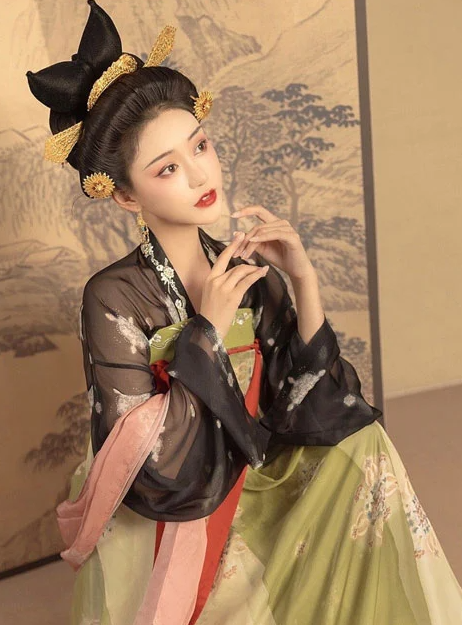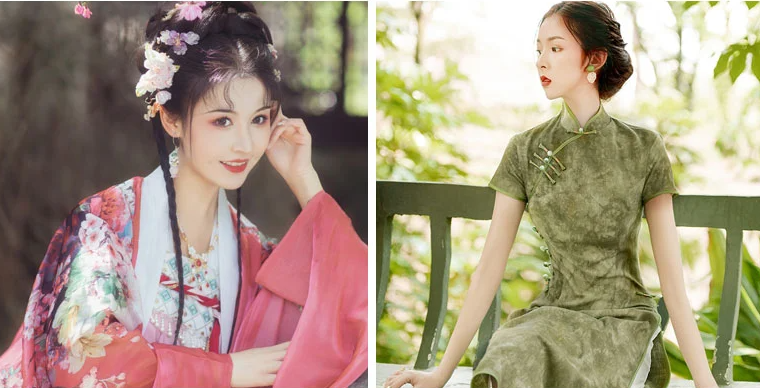Manchu clothing originates from the Manchu nomadic tribes, while Hanfu represents traditional Han Chinese attire.
Historical Context
The Rise of the Manchu Qing Dynasty
The Manchu people, originally known as the Jurchens, originated from the northeastern region of China, particularly in the areas now known as Jilin and Heilongjiang. During the 17th century, under the leadership of Nurhaci, they began consolidating various Jurchen tribes and established the Later Jin dynasty. His successor, Hong Taiji, later renamed it to the Qing Dynasty and continued the mission of expanding the dynasty’s reach.
By the mid-17th century, the Manchus had successfully crossed the Great Wall and captured Beijing, marking the official beginning of the Qing Dynasty’s rule over China. Their success can be attributed to their superior military strategies, the decay of the preceding Ming Dynasty, and the alliance with Ming’s internal rebels.
As the Manchus solidified their rule, they introduced various policies to ensure their dominance. Notably, they implemented the “Queue Order,” mandating all Han Chinese men to adopt the Manchu hairstyle of a shaved forehead with a braided ponytail as a sign of loyalty to the Qing.

The Dominance of the Han Culture before the Qing Dynasty
The Han people have been the dominant ethnic group in China for millennia. Their culture, traditions, and customs laid the foundation for what is known as Chinese civilization. Before the Qing Dynasty, the Han Dynasty and Tang Dynasty were particularly influential periods that showcased the zenith of Han culture.
Under the Han Dynasty, China expanded its borders, saw the Silk Road flourish, and Confucianism was established as the state ideology. The Tang Dynasty, on the other hand, is often hailed as the golden age of Chinese culture. During this era, arts, science, and literature thrived. The capital city, Chang’an (present-day Xi’an), became an international hub of culture and trade.
Aesthetic and Structural Differences
Fabric and Material Choices
Both Hanfu and Manchu attire utilize luxurious materials, but their choices often vary according to their cultural backgrounds and preferences.
Hanfu traditionally favored materials like silk, especially for ceremonial or high-status outfits. This choice is tied to ancient Chinese silk production, which dates back thousands of years. Linen and hemp were also commonly used for everyday wear, given their comfort and adaptability to various climates.
On the other hand, the Manchu, hailing from colder northern regions, often preferred thicker and warmer materials. Brocades, fur-lined robes, and heavy silk were commonly used to combat the frigid temperatures of their homeland. Additionally, with their hunting background, animal skins and furs were not uncommon in Manchu clothing.
Color Schemes and Symbolism
Color holds deep cultural and symbolic significance in both Hanfu and Manchu designs.
In Hanfu, colors often have symbolic meanings rooted in Confucian values and cosmic beliefs. For instance, yellow was often associated with royalty and the emperor, given its connection to the Earth’s center in the Five Elements theory. Green and blue, inspired by nature, signified growth and harmony.
Manchu clothing, while also utilizing symbolic colors, sometimes showcased different associations. Their royal robes, especially for the emperor, often used bright yellow, emphasizing their ruling status. However, their color palette was also influenced by their shamanistic traditions, leading to the incorporation of colors that might differ in meaning from Han interpretations.
Cuts, Layers, and Styles
The cut and style of clothing are perhaps the most noticeable differences between Hanfu and Manchu outfits.
Hanfu often features cross-collared robes, tied with a sash, and multi-layered designs, reflecting the clothing’s evolution over millennia. The styles varied widely based on factors like the wearer’s status, the occasion, and the current dynasty’s fashion preferences. For example, the Ruqun (a blouse-top paired with a skirt) is a classic Hanfu style popular among women.
Cultural Significance
Representation of Identity and Ethnicity
Clothing serves as more than mere protection from the elements; it acts as a canvas on which cultural, historical, and social narratives are painted.
Hanfu, with its intricate designs and unique style, has been a cornerstone of Han Chinese identity for millennia. It encapsulates the evolution of the Han civilization, portraying shifts in dynastic influences, artistic tastes, and societal norms. The presence or absence of certain features in Hanfu can tell tales of the wearer’s socio-economic status, marital status, or even their philosophical beliefs.
On the opposite side, the Manchu attire represents the story of a nomadic tribe that rose to rule one of the most powerful empires in world history, the Qing Dynasty. Their clothing was not just a matter of fashion, but a statement of identity and dominance. The mandatory “Queue Order,” for example, sought to integrate the Han Chinese under Manchu rule, making attire a focal point in their governance strategy.
Evolution of Dress and Culture Interplay
The interplay between dress and culture is a dance that has evolved with each passing era, influenced by various internal and external factors.
The Hanfu has witnessed many alterations, with each dynasty introducing its flair and modifications. The influence of neighboring cultures, from the Mongols during the Yuan Dynasty to the Central Asian aesthetics during the Tang Dynasty, enriched Hanfu’s designs, making it a mosaic of various Chinese historical periods.
Similarly, Manchu attire was not static. As they settled into their role as China’s rulers, the Manchus began to incorporate elements from Han culture and other subjugated ethnic groups. While they retained the core essence of their clothing, this amalgamation resulted in a more diversified wardrobe over time.
Social and Ritual Importance
Both Hanfu and Manchu clothing held pivotal roles in societal and ritualistic events.
Hanfu, for example, had specific styles and colors for various ceremonies, such as weddings, funerals, and ancestral rites. Rituals like the Confucian “capping” ceremony, which marked a boy’s transition to adulthood, had their unique set of attire, signifying the importance of the event.
Manchu clothing also had its ceremonial variations. For instance, during ancestral rites or shamanistic rituals, the choice of clothing, accessories, and colors played a crucial role in ensuring the ceremony’s success and the appeasement of spirits.
Functional and Practical Differences
Seasonal Variations and Adaptability
When evaluating clothing across different cultures, it’s vital to consider how they adapt to various climates and seasons. The Hanfu and Manchu attire have unique adaptability features that cater to different environments and weather conditions.
Hanfu:
- Summer Variations: Made from light materials like thin silk or cotton, these are designed to be breathable. They often have loose fittings to allow better air circulation. The lengths vary but are often longer to protect the skin from the sun.
Season Material Typical Length Summer Thin Silk 130-150 cm - Winter Variations: Typically made from heavier silk or layered with fur or padded cotton for insulation. These are tighter and closer to the body.
Season Material Typical Length Winter Heavy Silk with Fur Lining 140-160 cm
Manchu:
- Summer Variations: Though originating from colder regions, the Manchu adopted summer variations of their clothing after settling in various parts of China. These variations are made from breathable fabrics with less layering.
Season Material Typical Length Summer Breathable Fabric 125-145 cm - Winter Variations: Reflecting their northern origins, winter attire often includes thick brocades, heavy silks, and prominent fur linings, making them ideal for colder temperatures.
Season Material Typical Length Winter Brocade with Fur Lining 135-155 cm
Usage in Daily Life vs. Ceremonial Events
Clothing functions differ between day-to-day activities and special occasions. Here’s a breakdown of the Hanfu and Manchu attires based on their functionality:
Hanfu:
- Daily Life: Generally more simplistic in design, made from durable materials that can withstand daily wear and tear. They might be shorter in length for practicality.
Usage Material Typical Length Daily Durable Fabric 110-130 cm - Ceremonial Events: Elaborate designs with intricate patterns, often adorned with embroidery. Made from luxurious materials like fine silk, they signify the importance of the event.
Usage Material Typical Length Ceremonial Fine Silk with Embroidery 140-160 cm
Manchu:
- Daily Life: Like their Han counterparts, the Manchus also wore simpler and more functional attire for daily activities. These were often straight-cut and easy to move in, reflecting their nomadic origins.
Usage Material Typical Length Daily Functional Fabric 115-135 cm - Ceremonial Events: Ceremonial Manchu clothing, especially for the elite, was a spectacle. Incorporating rich colors, gold thread embroidery, and precious stones, these outfits represented the wearer’s status and the event’s significance.
Usage Material Typical Length Ceremonial Luxurious Fabric with Gold Thread 140-160 cm
Impact on Modern Fashion
Fashion, while always evolving, often draws inspiration from the past. The legacy of Hanfu and Manchu attire has not only been preserved in history books but also reverberates in the corridors of modern fashion. Their timeless elegance and profound cultural roots have left an indelible mark on contemporary trends.

Revival and Popularity in Modern Times
The turn of the 21st century saw a resurgence of interest in traditional clothing, with Hanfu leading the charge. Social media platforms, especially in China, have been inundated with young enthusiasts showcasing their Hanfu collections, participating in group outings, or even hosting Hanfu-themed events. This trend isn’t just a nod to the past but a powerful statement of cultural pride and reconnection with one’s roots.
While Manchu-inspired fashion, like the Qipao, had already seen a considerable level of mainstream acceptance, especially in the 20th century, there’s been renewed interest in exploring more authentic and diverse Manchu styles. These are no longer confined to ceremonial events but are being sported in daily life, film, television, and even on fashion runways.
Both styles have found allies in celebrities and influencers who, through their extensive reach, have introduced these traditional outfits to newer audiences, both within China and internationally. Websites, documentaries, and even academic courses on platforms like Coursera and Udemy have been dedicated to the study and appreciation of these cultural treasures.
Influence on Contemporary Designers and Fashion Trends
Leading fashion designers, both from China and globally, have been drawing inspiration from Hanfu and Manchu aesthetics. The flowing silhouettes of Hanfu, the intricate embroidery of Manchu robes, or the symbolism embedded in their designs have found their way into modern haute couture and ready-to-wear collections.
Brands have been fusing traditional elements with contemporary fabrics, cuts, and technology. For example, the fluidity of Hanfu-inspired dresses made with sustainable materials, or Manchu motifs printed using digital techniques on modern textiles, showcases a beautiful amalgamation of the old and the new.
Fashion weeks in major cities, from Shanghai to Paris, have witnessed collections that pay homage to these traditional styles, making them relevant to today’s global consumer. The cross-cultural exchanges, facilitated by globalization, have allowed designers from different backgrounds to interpret Hanfu and Manchu designs through their unique lenses, leading to exciting and diverse fashion innovations.